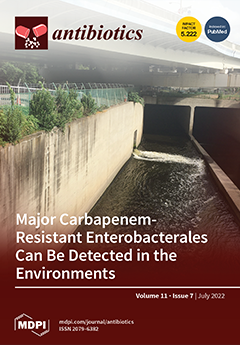The bacterium
Pseudomonas aeruginosa is known to be associated with nosocomial infections around the world. Pazufloxacin, a potent DNA gyrase inhibitor, is known to be an effective drug candidate. However, it has not been clarified whether the pharmacokinetic (PK)/pharmacodynamic (PD) of pazufloxacin was
[...] Read more.
The bacterium
Pseudomonas aeruginosa is known to be associated with nosocomial infections around the world. Pazufloxacin, a potent DNA gyrase inhibitor, is known to be an effective drug candidate. However, it has not been clarified whether the pharmacokinetic (PK)/pharmacodynamic (PD) of pazufloxacin was effective against
P.
aeruginosa. Herein, we demonstrated that the PK/PD index of pazufloxacin against
P.
aeruginosa infection is used to optimize the dosing regiments. We constructed an in vivo infection model by infecting
P.
aeruginosa into the thigh of a mouse to determine the PD, and we measured the serum concentration of pazufloxacin to construct the PK model using high-performance liquid chromatography. The therapeutic efficacy of pazufloxacin was correlated with the ratio of the area under the free concentration time curve at 24 h to the minimum inhibitory concentration (
fAUC
24/MIC), and the maximum free concentration to the MIC (
fC
max/MIC). Each contribution rate (R
2) was 0.72 and 0.65, respectively, whereas the time at which the free drug concentration remained above the MIC (R
2 = 0.28). The target value of pazufloxacin
fAUC
24/MIC for stasis was 46.1, for 1 log
10 it was 63.8, and for 2 log
10 it was 100.8. Moreover,
fC
max/MIC for stasis was 5.5, for 1 log
10 it was 7.1, and for 2 log
10 it was 10.8. We demonstrated that the in vivo concentration-dependent activity of pazufloxacin was effective against the
P.
aeruginosa infection, and successfully made the PK/PD model sufficiently bactericidal. The PK/PD model will be beneficial in preventing the spread of nosocomial infections.
Full article






